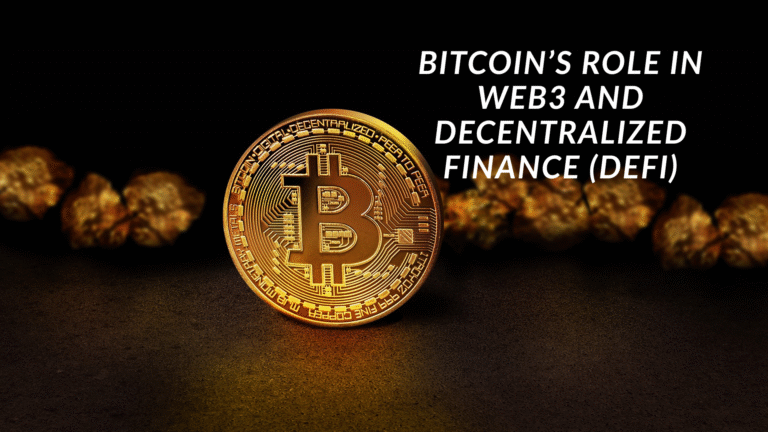Bitcoin’s Role in Web3 and Decentralized Finance (DeFi): The first decentralized cryptocurrency, Bitcoin, transformed international finance by establishing a peer-to-peer. Bitcoin was first intended to be digital currency, but it has now developed into a store of value and the basis for more extensive blockchain innovation.
Bitcoin’s function is growing beyond basic transactions as the world moves toward Web3, an internet based on decentralization, transparency, and user ownership. Developers are looking for novel integration strategies in the developing Decentralized Finance (DeFi) ecosystem.
Bitcoin’s Role in Web3 and Decentralized Finance (DeFi).

Bitcoin’s Role in Web3 and Decentralized Finance (DeFi): Bitcoin’s Role in Web3 and Decentralized Finance (DeFi)Bitcoin has been at the forefront of the digital currency revolution since its inception in 2009. Bitcoin, which started off as a peer-to-peer electronic cash system, introduced blockchain technology—a decentralized ledger that functions independently of banks and central authority. From a specialized experiment to a worldwide financial phenomenon, Bitcoin has developed over time into an asset class, a store of value, and a representation of financial independence.
However, Web3 and Decentralized Finance (DeFi), two new ideas that seek to expand decentralization beyond currency into applications, governance, and the wider internet, have surfaced as the blockchain sector develops. Bitcoin is still the original cryptocurrency, but its interactions with these other systems are intricate and constantly changing.
Bitcoin’s Foundational Role in Decentralization.
- Decentralization as a Principle: Bitcoin proved that financial systems could operate without centralized intermediaries. This principle—trusting code instead of institutions—became the cornerstone of Web3 and DeFi.
- Immutable and Transparent Ledger: Bitcoin’s blockchain was the first successful implementation of a distributed ledger that records transactions transparently, providing the foundation for the “trustless” systems that DeFi depends on.
- Native Digital Asset: Bitcoin introduced a purely digital form of money, paving the way for other crypto assets that could represent tokens, smart contracts, and decentralized applications.
In short, Bitcoin was the prototype of the decentralized internet economy that Web3 envisions.
Understanding Web3 and DeFi.

The next generation of the internet, or Web3, is characterized by decentralized networks that give individuals authority over their data, identities, and digital assets. Web3 redistributes power to users and producers through the use of blockchain, encrypted identity, and token-based economy, in contrast to the present Web2 model that is dominated by huge businesses.
One of Web3’s main components, DeFi, focuses on financial services that do not employ middlemen. DeFi makes it possible to lend, borrow, trade, and earn interest—activities that are typically managed by banks or centralized exchanges—by using smart contracts and decentralized protocols.
DeFi now relies heavily on platforms like Ethereum, Solana, and Avalanche because they enable smart contracts, which are blockchain-based programs that can function on their own. Such intricate scripting is not natively supported by Bitcoin by design. As a result, many people now consider Bitcoin to be relatively unrelated to the Web3 and DeFi revolutions.
However, this perception is changing.
Bitcoin’s Challenges in the Web3 Ecosystem.
Some of its main challenges include:
- Lack of Smart Contracts: Bitcoin’s scripting language is intentionally simple for security reasons. It doesn’t support the rich smart contract functionality required by DeFi protocols like automated lending or yield farming.
- Scalability: Bitcoin’s network processes only a limited number of transactions per second (around 7 TPS), making it unsuitable for the high-volume activity typical of DeFi platforms.
- Ecosystem Isolation: Many DeFi and Web3 innovations occur on Ethereum and other smart contract chains, leaving Bitcoin relatively siloed unless bridged through interoperability solutions.
Bridging Bitcoin to DeFi: Wrapped and Layered Solutions.
- Wrapped Bitcoin (WBTC)
Wrapped Bitcoin (WBTC), an Ethereum ERC-20 token that 1:1 reflects Bitcoin, is one of the most effective bridges between DeFi and Bitcoin. Every WBTC is supported by a corresponding Bitcoin that is kept in reserve. - Through WBTC, Bitcoin becomes a productive asset—it can be lent, borrowed, or used as collateral—something impossible on Bitcoin’s native chain.
- Sidechains and Layer-2 Networks
Projects like RSK (Rootstock) and Stacks extend Bitcoin’s capabilities by connecting sidechains or layer-2 solutions that support smart contracts.
-
RSK: A Bitcoin sidechain that brings Ethereum-compatible smart contracts to Bitcoin, enabling DeFi applications secured by Bitcoin’s hash power.
-
Stacks: A layer-2 blockchain that settles transactions on Bitcoin and introduces smart contracts through the Clarity programming language.
- These technologies effectively bridge Bitcoin with the DeFi world, maintaining Bitcoin’s security while expanding its functionality.
- Lightning Network
The Lightning Network is a type of financial innovation based on Bitcoin, albeit its primary focus is on scalability and microtransactions. It makes quick, inexpensive payments possible and may be the basis for Web3 environments’ decentralized payment systems.
Bitcoin in Web3: Beyond Finance.
- Digital Identity and Proof of Ownership
Web3 apps can use the blockchain of Bitcoin as a proof-of-existence or timestamping layer. Ordinal inscriptions and Bitcoin NFTs (BRC-20 tokens), for instance, record unique digital assets using the blockchain of Bitcoin. - Open Source Ethos and Governance
Web3 prioritizes open development and community-driven governance. It acts as a model for governance in other decentralized systems. - Economic Foundation
Bitcoin continues to function as the reserve asset of the crypto economy. Many DeFi protocols use wrapped or tokenized Bitcoin as collateral because of its stability, liquidity, and brand trust.
Emerging Trends: Bitcoin DeFi (BTCFi).
A new trend called Bitcoin DeFi (or BTCFi) is gaining traction, aiming to bring DeFi natively to the Bitcoin network. Innovations include:
- BitVM: A recently proposed framework that could enable more complex smart contracts directly on Bitcoin without altering its base protocol.
- RGB Protocol: A layer that allows the creation of digital assets and smart contracts anchored to Bitcoin.
- Liquid Network: A Bitcoin sidechain developed by Blockstream that enables faster transactions and token issuance—useful for decentralized exchanges and security tokens.
These developments suggest that Bitcoin’s integration into Web3 and DeFi is still in its early stages but rapidly progressing.
The Philosophical Significance.
Bitcoin has a philosophical as well as a technological role in Web 3. Web3 seeks to create an open, user-owned, and censorship-resistant internet—the same ideals that drove the development of Bitcoin.
Although Ethereum and other more recent platforms have added programmability to these concepts, Bitcoin continues to represent trustless decentralization.
The Future Outlook.
Looking forward, Bitcoin’s relationship with Web3 and DeFi will likely deepen through continued innovation:
- Cross-chain interoperability will make Bitcoin more fluid across blockchain ecosystems.
- Layer-2 advancements like Stacks and Lightning will bring Web3-style functionality to Bitcoin’s network.
- Institutional adoption and regulatory clarity will position Bitcoin as both a DeFi asset and a Web3 reserve currency.
The trust and security of Bitcoin are ultimately what give it its lasting value. In an increasingly complicated decentralized environment.
Conclusion.
Bitcoin is still the cornerstone of the decentralized movement even though it may not be the most adaptable blockchain for smart contracts or DeFi innovation.
Bitcoin is establishing itself as a crucial component of the Web3 economy and as digital gold in the rapidly changing field of decentralized finance through wrapped tokens, sidechains, and new protocols.
Bitcoin’s future in Web3 and DeFi appears increasingly bright as developers keep closing the gap. It will continue to serve as a repository of value and a wellspring of confidence.

